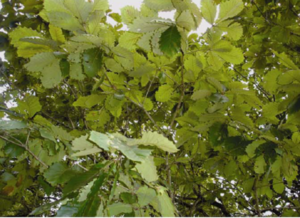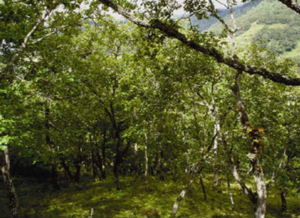The Monpa tribe is one of the most populous tribes of Arunachal Pradesh and is considered as one of the major tribal communities in the entire region. Monpas are the inhabitants of the high altitude Tawang district and the mountain passes of Bomdila in West Kameng district. Historically, the Tibetan word Monpa referred to all the indigenous tribes of southern Tibet and Bhutan, who were considered barbaric by the highly civilized Tibetan Buddhists. Mera Lama of Tibet spread Buddhism in southern Tibet and converted these Monpas into Gelugpa faith of Tibetan Buddhism.
Monpa tribe has developed their location specific indigenous strategy for sustainable biodiversity conservation and overall natural resource management at community level. They follow many practices for conserving the indigenous forest trees and thereby agro-biodiversity. Maize is a staple food crop, managed, produced and conserved with the natural dynamics of indigenous species of Paisang [Quercus rex (Hemsl.) Schottky, Oak tree] and Roinangsing and Lenthongsing (pine species, Pinus wallichiana A. B. Jacks. and Pinus roxburghii Sarg.).

Leaves of Paisang, a deciduous woody perennial tree found in the sloppy hilly terrains, fall from last week of January and continue up to last week of February. This is the peak period when women folk make the group called Mila to collect and carry the dry leaves of Paisang from community based groves/forest and private land. A complete indigenous package based on utilization of dry leaves of Roinangsing and Lenthongsing (Pinus wallichiana A. B. Jacks. and Pinus roxburghii Sarg.) and Paisang helps the farmers to sustain the agro-ecosystem and get stable organic production.
Local varieties of maize are grown in the last week of April to first week of May. Dry leaves of Paisang and pine tree are collected by women folk. The dry leaves are kept either in shade behind the foothill against the direction of wind to avoid direct sunlight on leaves and save from speedy wind, respectively. In sloppy areas having light textured soil, pine leaves are preferred as mulch and source of organic matter because oil of leaves helps in binding the soil particles, thereby keeping the soil intact, preventing soil erosion and protecting the leaves from speedy wind.
Interestingly, the rate of weed suppression (allelopathic effect), improvement of soil fertility and total biomass from the local varieties of maize, rajma bean, soybean and cucumber is 30-40% more in the land where Paisang leaves are applied compared to the fields where such practice is not followed. It has been found that during ancient time, the poor people of Monpa tribe use to go to the village Zamindar (landlord) for Paisang tree dry leaves for using in agricultural crops. For this, they had to give one bamboo made bottle of Rakshi , fine quality of local beer prepared from indigenous barley or maize, showing importance of Paisang tree.

Monpa tribe has developed the location specific indigenous practices for conserving the indigenous crop varieties, grown by only using the dry leaves of Paisang and pine. Seeds of local variety of maize are spread in the fallow land, ploughed using the bullock drawn local plough, then the collected dry leaves are spread uniformly over the soil primarily by the women folk. There are three indigenous varieties of maize, namely Fenthina (dwarf variety, duration 3 months), Thinasheru (tall variety, duration 5 months) and Baklangboo, [medium tall variety sown in Lohsar festival (January to February), duration 4 months]. These indigenous varieties are location specific in nature and grown under varying micro-farming situations by applying the dry leaves of Paisang. Fenthina is grown in most fertile soils near kitchen gardens, Thinasheru is grown in main agricultural land where soil is black to brown and land is undulating, while Balangboo is cultivated in gentle slope and shifting land. Less quantity of dry leaves of Paisang are used in black soil than in light textured and undulating lands.
The selection of crop species and types of cropping (mostly mixed) is decided by whole community of village based on amount of Paisang tree leaves to avoid the crop loss and sustain the crop productivity. If maize is grown after using the dry leaves of Paisang and pine as natural mulch, then there is a better opportunity to increase the productivity of crops by diversifying the cropping systems. When ample quantity of dry leaves of Paisang is available as organic manure, then the indigenous varieties of black gram, soybean and rajma bean are incorporated as mixed crop.
To conserve the Paisang, pine trees and local crops, Chheskaran festival is celebrated during March for the spirit to protect them from insect pests and evils. With the passage of time, some changes have been seen in the methods of use of Paisang leaves. About 20 yrs back, semi decomposed leaves of Paisang tree were used in the standing crop of maize and other crops to increase the fertility, control soil erosion, conserve soil moisture and suppress the weed intensity. The women folk collect the dry leaves of Paisang from private and community forest and store in the agricultural fields in a specially made bamboo structure. The leaves were piled tightly and left till the onset of rains for decomposition. When the reddish solution is secreted from the bottom of stored leaves, it indicates that leaves are partially decomposed and are ready to apply in maize and other local crops. Now a days the dry leaves are directly collected and used (as mulching material cum organic matter just after sowing of maize seeds) without partial fermentation.
The changes in governance and over exploitation of Paisang tree had a negative impact on the environmental and socioeconomic sustainability. These impacts can be characterized in terms of size, sustainability and soil fertility of crops. During early period, local people were totally dependent on the leaves of Paisang and pine. But with the passage of time, rate of using the leaves of these trees have decreased considerably among the newer generation. Therefore, a measurable degree of cultural diversity has been lost from Monpa tribe.
Some of the commercial growers of fruit crops have converted their private Paisang land into apple orchards, resulting in loss of ecological and cultural benefits. Some of the influential people of the locality have encroached upon community land of Paisang tree and cut many trees. The fragmentation of land holdings also makes a community vulnerable to losing control over the portion of community Pasiang forest that is distant from villages. Paisang tree is the backbone of local people’s culture and the loss of this resource system may eventually precipitate a decline in Monpa tribe’s cultural diversity

Looking to the importance of Paisang tree the community institution called Chhopa have developed some local norms and rules to sustain its population and avoid conflict. The private and community Paisang tree lands are demarcated separately using stones. This helps to avoid any conflict between the owners while accessing the leaves. If someone is collecting leaves beyond the demarcated areas assigned or overexploiting the paisang tree, then fine is imposed by Chhopa headed by Gaon Burha (chief of the village selected by villagers based on age and experience) . In this process, the Gaon-Burha files a case before the Chhopa and guilty person is called for giving explanations. If he is found guilty, a fine is imposed. In earlier days, the fine was imposed in terms of yak, cow, pigs and sheep. The size and age of animals given as fine is decided according to the nature, productivity and age of the cut the Paisang tree. If the fined person is not able to bear it, then fine is given by his close relatives. The Chhopa reserves the right to reduce the fine depending on economic status of the guilty person. The collected money from the imposed fine is used by the community for social welfare, managing natural resources like plantation in community land, hillside and roadside to avoid landslides. Everybody honours the decision made by the Chhopa. But with the passage of time some changes have taken place in this local institution.
Source
https://greenerpasturesind.wordpress.com/2014/09/03/monpa-tribe-of-arunachal-pradesh/
http://nopr.niscair.res.in/handle/123456789/6941


